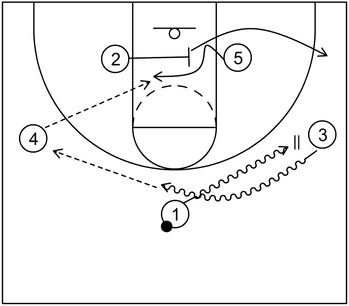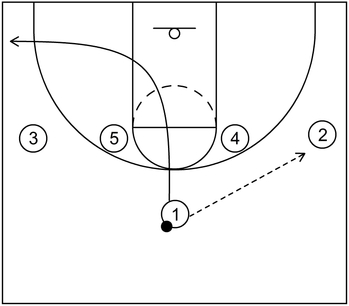What is the cross screen in basketball
The cross screen comprises basketball action that occurs when one offensive player sets a screen, typically near the middle of the lane, on a defender who is guarding a second offensive player. Afterwards, the second offensive player can then use the screen to get open and receive the ball for a possible scoring opportunity around the basket.
Additionally, although the cross screen is generally set in the lane, also known as the paint or the key, particularly in front of the rim, it could also be set near the middle of the high post area as well.
Nevertheless, this high post variation is usually not as common as the cross screen set near the basket in the lane.
Moreover, in most instances, the offensive player that sets the cross screen is usually a guard, or smaller player in general, while the offensive player that utilizes the cross screen is commonly a post player, or bigger player in general.
However, in certain situations, it is possible for two post players to execute cross screen action, particularly near the high post areas, although once again, that is usually not as common.
Why is the cross screen potentially effective
The cross screen is potentially effective, primarily because it is a type of basketball screen that is typically executed to create a scoring opportunity near the basket.
In other words, the general purpose of the cross screen is to produce a high percentage shot near the basket.
This is the exact opposite of other types of screens such as the down screen or the flare screen, which could be used to create open space for players near the perimeter and away from the basket.
In even more simple terms, if an offensive player is able to get open by way of a cross screen, then there is a very high chance that same player will be able to score quickly and efficiently, assuming they receive the ball while open.
Furthermore, if a guard sets a cross screen for a low post player while in the process of executing the team’s basketball offense, then this could lead to potential defensive mismatches.
Essentially, if a low post defender gets caught on the cross screen of a guard, then as a result, that same low post defender’s assignment (i.e. the low post offensive player) would be open to receive the ball and potentially score near the basket.
Therefore, to remedy that situation, the screener’s defender (i.e. another guard) might decide to execute a defensive switch so that the offensive low post player, at the very least, does not have a free look at the basket.
The problem, of course, is that if the screener’s defender is smaller than the low post player, then it is still a defensive mismatch, which could result in a scoring opportunity for the low post player.
Why is the cross screen potentially limited
The cross screen is potentially limited because the offensive player that uses the screen typically only moves a short distance, generally from one post area to the opposite post area and this basically means that the timing for that same offensive player to stay open is not very long.
In other words, if the defender being targeted by the cross screen successfully fights through it or simply avoids it altogether, then that same defender would not have to travel a long distance to close the gap between themselves and the offensive player that they would be guarding.
Therefore, if an offensive player gets open via the cross screen, the time frame that they could receive the ball is usually very short and if that same offensive player does not receive the ball in that small time frame, then it is almost certain they will no longer be totally open for an uncontested scoring opportunity.
Affiliate Disclosure: I may earn a commission on qualifying purchases made through the links below.
What are examples of simple basketball plays that use the cross screen
Example 1

This is an example of a basketball play that features a cross screen as well as dribble handoff action within a 3 out 2 in set.
To begin, 1 executes a dribble handoff with 3 near the right side wing area. Following that, 3 dribbles back towards the top and then 4 receives the ball from 3.
As that occurs, 5 cuts into the lane via the cross screen set by 2. Afterwards, 5 could score by way of a layup, dunk, or low post move while 2 cuts through to the right side corner.
Example 2

This is an example of a basketball play that demonstrates a cross screen as well as screen the screener action, particularly via the down screen.
To start, 3 receives the ball from 4 and as that happens, 5 cuts across the lane via the cross screen set by 2.
Next, 2 cuts to the top via the down screen set by 4 and from there, 4 cuts through to the right side wing while 1 fills the right side corner.
After that occurs, 5 can receive the ball from 3 and score near the basket via a layup or low post move.
Alternatively, 2 could receive the ball at the top after the down screen action for a possible three-point jump shot.
Example 3

This is an example of a quick hitting basketball play initiated from a 1-4 high alignment that showcases a cross screen near the high post area, which could then lead to potential scoring opportunities near the basket.
To start, 2 receives the ball from 1 and afterwards, 5 could cut to the left side low post area via the cross screen set by 4. At the same time, 4 could immediately slip to the basket following the screening action.
From that point, 5 could receive the ball from 2 and score via a low post move. Alternatively, 4 could receive the ball and score at the rim via a layup or dunk.
Example 4 – Part 1

This is an example of a basketball play that utilizes cross screens as well as ball screens via a 1-4 high alignment to create scoring opportunities near the basket.
It is based on insights within High/Low Motion Offense Sets with Special Situations by Steve Forbes.
To begin, 2 receives the ball from 1 and afterwards, 1 cuts away to the left side corner on the weak side of the floor.
Example 4 – Part 2

Next, 5 cuts toward the right side wing via the high post cross screen, which is also a ram screen, set by 4.
The initial intention of 5 is to get in proper position to set an on-ball screen on the defender guarding 2. However, this is simply false action as 5 will slip the screen, which is especially helpful against a defensive hedge or ball screen blitz.
From that point, 5 could receive the ball while slipping to the rim and then score by way of a layup or dunk if that is available.
If 5 cannot initially receive the ball during the slip action, then 5 could step out of the lane to fill the right side low post block. After that, 5 could receive the ball from 2 and score near the basket, particularly with a low post move.
Example 4 – Part 3

If 5 is not able to receive the ball via the slip action or by way of the low post entry pass, then 2 dribbles toward the high post area via an on-ball screen set by 4.
Also, as that action happens, 1 sprints into the lane from the left side corner to set a cross screen on the defender that would be guarding 5.
Following that, 5 cuts underneath the cross screen and looks to quickly receive the ball in the lane, preferably by way of a bounce pass. From that point, 5 could score via the layup or dunk at the rim.
Example 5 – Part 1

This is an example of a basketball play that uses a cross screen alongside a wide pin down screen and dribble handoff action to generate a scoring opportunity near the basket,
It is based on information within Favorite Horns Offense & Actions by Cheryl Reeve. To start, 4 receives the ball from 1 at the right side high post elbow.
After that happens, 3 cuts to the left side wing near the extended left slot by way of a wide pin down screen set by 5. At the same time, 1 cuts toward the right side high post elbow to execute a handoff with 4.
However, that is false action so 1 does not receive the ball from 4. Instead, 1 simply cuts outward to the empty right side wing area.
Example 5 – Part 2

Next, 4 executes a dribble handoff with 3 near the left side high post elbow area while 2 sprints into the lane to set a cross screen on the defender that would be guarding 5.
Following that, 3 receives the ball from 4 and proceeds to dribble it once or twice towards the free throw line area. As that basic dribble action occurs, 5 cuts under (or over) the cross screen set by 2.
If the timing is correct, then 5 should be open briefly to receive the ball from 2 and score at the rim via a layup or dunk.
What are basic examples of cross screen defense
These are basic examples that demonstrate how the opposing team could defend against the cross screen, particularly near the basket.
Example 1

This is an example of defensive action against the cross screen that could occur when the cutter goes over the top of the screen to the low post block.
To start, 3 receives the ball from 1 and when that happens, 2 steps into the lane to set a cross screen on X5.
As that occurs, X2 could lessen the effectiveness of the cross screen by temporarily stepping into the pathway of 5, with a hand (in this case, the right hand) high in the passing lane, similar to denial defense.
Following that, X5 could go under the cross screen and recover to guard against 5 while X2 recovers back towards 2.
Example 2

This is an example of defensive action that could occur if the offensive team utilizes a big to big cross screen near the basket.
It should be noted as well that this big to big switching tactic assumes that X4 on defense and 5 on offense are roughly about the same size.
If X4, typically a defensive power forward, is much smaller than 5, usually an offensive center, then this defensive switch might not be as effective.
To start, 3 receives the ball from 1 and afterwards, 4 steps into the lane to set a cross screen on X5.
When that happens, X4 and X5 can simply execute a defensive switch to mitigate the effectiveness of the cross screen. So, when 5 goes over (or under) the screen, X4 switches over to guard 5 while X5 switches over to guard 4.